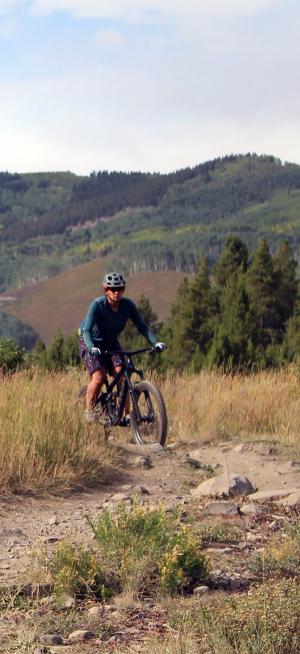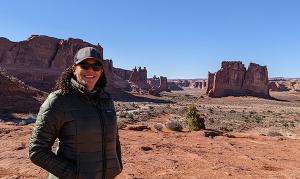Five questions for Cerian Gibbes
An associate professor in the Department of Geography and Environmental Studies at the University of Colorado Colorado Springs, Cerian Gibbes this year was named a President’s Teaching Scholar, a title recognizing excellence in and commitment to learning and teaching, as well as active, substantial contributions to scholarly work.
Gibbes teaches Environmental Remote Sensing, Statistical Analysis in Geography, Urban Sustainability, and Geography of Africa. Her research focuses on the social and ecological impacts of environmental change, often examining the intersection of agriculture and conservation.
“I am interested in how communities decide to use land and how those land-use decisions impact the environment and the people most directly connected to that land,” Gibbes said. “Sometimes agriculture and conservation are competing land uses, but they can also coexist in ways that benefit both the environment and society.”
Global exploration is a theme of her leisure pursuits, too, as Gibbes enjoys traveling and learning about new places.

“This interest began when I first traveled internationally as a child and adolescent to compete in swimming competitions,” she said. “Each year I push myself to do something new or unfamiliar. Last year, I took a mountain biking course, which was good fun and pushed me to ride trails I would never have attempted. This year, I started learning Portuguese. These experiences allow me to be a student, which is good for my continued learning but also constantly reminds me what it is like to be a novice and I think this is helpful for teaching.”
Her academic career will have her on the move again next year: Gibbes was selected for a Fulbright Fellowship, which will take her to Taiwan. The program was delayed due to COVID-19 and is expected to start in the summer of 2023.
1. You grew up in a rural community in Trinidad and Tobago. How did that experience affect your career path?
I grew up in a valley in the northern part of the country. The valley was once a significant cocoa production area, and during my childhood the landscape mostly consisted of abandoned plantations and small-scale agriculture. It has since developed significantly. I remember as a child spending a lot of time outside. I think this part of my childhood sparked my interest in the environment. It also served to provide me with lived experiences that I could directly relate to physical geography.
For example, I remember playing a game where my siblings and I would race through the rain to the trees in our yard with the goal of staying as dry as possible. This game was premised upon the concept of interception. As a child this game was just something fun to do when it rained, but as an undergraduate student in a hydrology course I was able to make a clear link between that part of my life and an important component of the hydrological cycle. This link between course content and my life made the concept I was learning about relevant and accessible. I try to carry this over into my classes by exploring with students the links between geographic concepts to their day-to-day lives.
2. You have co-taught travel courses to Uganda, Rwanda and Guatemala. What do students and educators gain from these experiences?
These field courses were co-led with faculty from my department, Sociology (UCCS) and Public Affairs (CU Denver). Co-teaching these courses provided students with an opportunity to learn from individuals with expertise – geographic and thematic – relevant to the student’s degree programs and to the travel course.
While students can certainly enjoy many forms of the travel, the opportunity to take a field course and learn about a space guided by individuals with geographic and/or thematic expertise is incredibly valuable and promotes the connection between student experience and established knowledge.
These courses gave me the opportunity to learn from my colleagues. Also, the conversations with students during these courses let me see spaces from the students’ perspectives.
It is important to think about the world from the perspective of others; I think this can energize our imagination. Students bring different backgrounds and experiences to travel courses which contribute to the creation of a rich, sometimes unexpected, collective learning experience for both student and faculty.
3. You have said your teaching relies on a “challenge and support” approach. How do you define that?
For me, teaching is based on the development of positive student-faculty relationships. I try in each course to see and value the individuality each student brings to the class. By first understanding who each student is and what experiences have shaped/are shaping them, I can then combine this with a challenge-and-support framework.
This means encouraging (challenging) students to stretch their thinking beyond its current level and simultaneously providing an appropriate (to each of them) degree of support so that students are engaged, and learning occurs. My intent is to provide a space in each course where students not only learn the academic content but also grow as learners and thinkers. This space ideally accepts that learning requires effort and is exciting.
4. How has your teaching evolved since the onset of the pandemic?
Teaching is a process that requires continuous revision and learning on my part. While the pandemic was certainly disruptive, I tried to use this period as a learning opportunity, a chance to reflect on my assumptions about how students engage with course content.
We initially had to shift much of our course content to online delivery formats. I think there is immense value in the in-person interactions that occur among students, and between students and faculty, in the classroom. At the same time, I have found that some of the digital content that I created in response to the pandemic helped student learning. So, I am in the process now of determining which components of course content created during the pandemic need to be retained and how best to integrate these with in-person learning experiences.
5. What does it mean to you to be named a President’s Teaching Scholar at CU?

It is an honor. To be honest, it was an honor just to be nominated, but to have the chance to connect and learn with the outstanding scholars in the President’s Teaching Scholars Program is a privilege. I am very grateful for the support colleagues and students gave me during the application process, and I look forward to the opportunity to contribute to CU-wide programs that promote teaching and learning.
This summer, with a fellow President’s Teaching Scholar, Andrea Herrera, I am co-designing a course focused on Caribbean history, environment and society. I am also excited to be part of a team, led by fellow President’s Teaching Scholar Laurel Hartley, that will implement effective uses of the undergraduate Learning Assistant model to enhance student learning.


